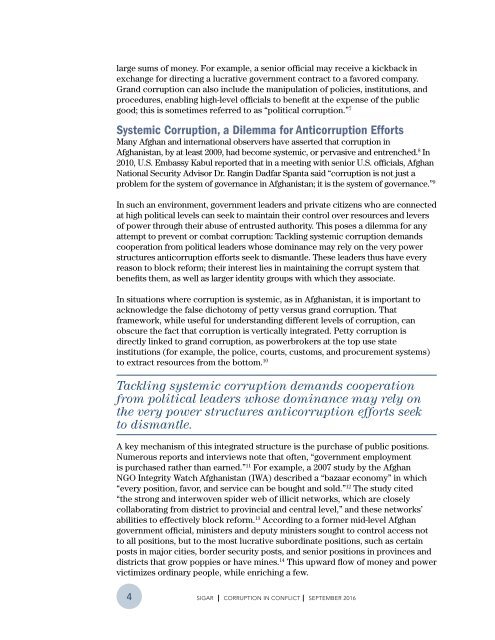CORRUPTION IN CONFLICT
5IlaWjQej
5IlaWjQej
Create successful ePaper yourself
Turn your PDF publications into a flip-book with our unique Google optimized e-Paper software.
large sums of money. For example, a senior official may receive a kickback in<br />
exchange for directing a lucrative government contract to a favored company.<br />
Grand corruption can also include the manipulation of policies, institutions, and<br />
procedures, enabling high-level officials to benefit at the expense of the public<br />
good; this is sometimes referred to as “political corruption.” 7<br />
Systemic Corruption, a Dilemma for Anticorruption Efforts<br />
Many Afghan and international observers have asserted that corruption in<br />
Afghanistan, by at least 2009, had become systemic, or pervasive and entrenched. 8 In<br />
2010, U.S. Embassy Kabul reported that in a meeting with senior U.S. officials, Afghan<br />
National Security Advisor Dr. Rangin Dadfar Spanta said “corruption is not just a<br />
problem for the system of governance in Afghanistan; it is the system of governance.” 9<br />
In such an environment, government leaders and private citizens who are connected<br />
at high political levels can seek to maintain their control over resources and levers<br />
of power through their abuse of entrusted authority. This poses a dilemma for any<br />
attempt to prevent or combat corruption: Tackling systemic corruption demands<br />
cooperation from political leaders whose dominance may rely on the very power<br />
structures anticorruption efforts seek to dismantle. These leaders thus have every<br />
reason to block reform; their interest lies in maintaining the corrupt system that<br />
benefits them, as well as larger identity groups with which they associate.<br />
In situations where corruption is systemic, as in Afghanistan, it is important to<br />
acknowledge the false dichotomy of petty versus grand corruption. That<br />
framework, while useful for understanding different levels of corruption, can<br />
obscure the fact that corruption is vertically integrated. Petty corruption is<br />
directly linked to grand corruption, as powerbrokers at the top use state<br />
institutions (for example, the police, courts, customs, and procurement systems)<br />
to extract resources from the bottom. 10<br />
Tackling systemic corruption demands cooperation<br />
from political leaders whose dominance may rely on<br />
the very power structures anticorruption efforts seek<br />
to dismantle.<br />
A key mechanism of this integrated structure is the purchase of public positions.<br />
Numerous reports and interviews note that often, “government employment<br />
is purchased rather than earned.” 11 For example, a 2007 study by the Afghan<br />
NGO Integrity Watch Afghanistan (IWA) described a “bazaar economy” in which<br />
“every position, favor, and service can be bought and sold.” 12 The study cited<br />
“the strong and interwoven spider web of illicit networks, which are closely<br />
collaborating from district to provincial and central level,” and these networks’<br />
abilities to effectively block reform. 13 According to a former mid-level Afghan<br />
government official, ministers and deputy ministers sought to control access not<br />
to all positions, but to the most lucrative subordinate positions, such as certain<br />
posts in major cities, border security posts, and senior positions in provinces and<br />
districts that grow poppies or have mines. 14 This upward flow of money and power<br />
victimizes ordinary people, while enriching a few.<br />
4<br />
SIGAR I <strong>CORRUPTION</strong> <strong>IN</strong> <strong>CONFLICT</strong> I SEPTEMBER 2016


